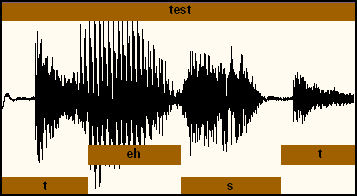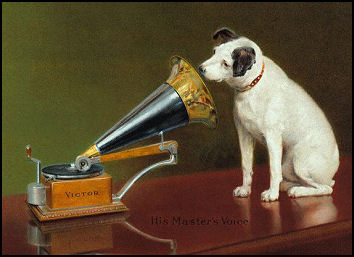Voice Recognition
Didja ever notice that Captain Kirk never had to fuss with a mouse or keyboard to communicate with the computer on the Star Trek? He simply spoke direct commands at the machine, and the computer complied. Happily, voice recognition technology has moved from the bridge of the Enterprise to your home computer. Here's how to get started with voice computing... |

What Is Voice Recognition Software?
Simply put, voice recognition software allows you to speak commands to a computer rather than use a mouse or keyboard. Though it may seem like a futuristic notion, voice computing or speech recognition has been around for over a decade, and is still a rapidly evolving technology. Even though it's not used by many on their home PCs, you probably have already encountered this type of data input. A lot of companies, especially telecom providers, are already using voice-recognition when you call their customer service centers. You can answer "Yes" or "No" or other specific phrases to questions that the voice-activated system asks, rather than pressing "1" for "Yes" or "2" for "No". Also, more and more vehicles are now coming equipped with voice recognition computers that let the driver operate the radio, CD player, or a cell phone.
How Does Voice Recognition Work?
 Without getting too terribly geeky, a person's voice is translated into a digital format that a computer can read. Sound travels in waves, and the range of sounds we can hear are created by changing the height (amplitude) and frequency of those waves. So by examining the "voiceprint" of a spoken word or phrase, and comparing it to the sound waves created by speaking specific utterances, the computer can make a pretty good guess at what you said. In a nutshell, it's pattern matching.
Without getting too terribly geeky, a person's voice is translated into a digital format that a computer can read. Sound travels in waves, and the range of sounds we can hear are created by changing the height (amplitude) and frequency of those waves. So by examining the "voiceprint" of a spoken word or phrase, and comparing it to the sound waves created by speaking specific utterances, the computer can make a pretty good guess at what you said. In a nutshell, it's pattern matching.
In situations where the only options are "Yes" and "No" it's a lot easier for a computer to figure out which word you said, because they sound quite different. It obviously gets trickier when the voice recognition software has to figure out what you said in a larger context. And because human vocal patterns are as varied as humans, with individuals having different accents and inflections, voice recognition software must typically be trained to identify the way words are spoken by a particular user.
Want to Try Voice Recognition Software?
You can buy software available that will allow you to speak commands to your PC. Perhaps the most common reason to use voice recognition, with all apologies to Mavis Beacon, is to eliminate the need for typing by dictating. No more two-finger pecking at a keyboard to create letters, e-mails, school reports, and such; just sit back and talk at your PC. And of course it's a boon to those with physical disabilities.
The most popular voice recognition software currently available to accomplish this is Dragon Naturally Speaking created by a company called Nuance. With this software, you can dictate text in a word processor such as MS Word, navigate through the Windows desktop or surf with Internet Explorer. The latest version, 9.0 Professional comes with a microphone, and the program comes with support for Bluetooth wireless headsets.
 The installation is painless; simply follow the prompts. The most time-consuming part of using Dragon is training the program to recognize your voice. It can take about two weeks of consistent use to get the program to fully understand your words. But hey, that's still less time than it takes to get carpal tunnel from typing. Nuance boasts 95% accuracy with word recognition, but many users claim that the reality is more like 80-85%. There also seems to be an issue with dictating numbers in a spreadsheet program. If you are, for example, using Excel, and you say "10", Dragon will type out the word "ten". You have to say, "numeral 10." Be warned, you will also need at least a 1Ghz processor, 512 MB of RAM, 1 GB of free hard disk space and Windows XP/2000 to run this program efficiently.
The installation is painless; simply follow the prompts. The most time-consuming part of using Dragon is training the program to recognize your voice. It can take about two weeks of consistent use to get the program to fully understand your words. But hey, that's still less time than it takes to get carpal tunnel from typing. Nuance boasts 95% accuracy with word recognition, but many users claim that the reality is more like 80-85%. There also seems to be an issue with dictating numbers in a spreadsheet program. If you are, for example, using Excel, and you say "10", Dragon will type out the word "ten". You have to say, "numeral 10." Be warned, you will also need at least a 1Ghz processor, 512 MB of RAM, 1 GB of free hard disk space and Windows XP/2000 to run this program efficiently.
Currently, Dragon Naturally Speaking is not available for Mac OS systems. The premiere Mac program for voice recognition is iListen, but you can try Apple's Speech Recognition feature built into OS X. Windows Vista also comes with its own voice recognition software, though some say it is not as accurate as Dragon's program. There are other programs available that will allow you to dictate to your computer, some are task-specific; only recognizing math functions or e-mail commands. Here's a comprehensive (but dated) list of voice recognition software options.
At this time, there is no one program that you can use "out-of-the-box" that will transcribe your dictation or your PC commands perfectly. Dragon is the leader of the pack in the PC market so far, but voice recognition has a way to go before perfectly recognizing words other than "Yes" or "No". So Captain Kirk, you can keep that smug look on your face, but watch your back... software developers are putting a lot of time and energy into creating better voice recognition programs.
|
|
|
This article was posted by Bob Rankin on 22 Mar 2007
| For Fun: Buy Bob a Snickers. |
|
Prev Article: What is Bluetooth? |
The Top Twenty |
Next Article: TV as Computer Monitor |
Post your Comments, Questions or Suggestions
|
Free Tech Support -- Ask Bob Rankin Subscribe to AskBobRankin Updates: Free Newsletter Copyright © 2005 - Bob Rankin - All Rights Reserved About Us Privacy Policy RSS/XML |
Article information: AskBobRankin -- Voice Recognition (Posted: 22 Mar 2007)
Source: https://askbobrankin.com/voice_recognition.html
Copyright © 2005 - Bob Rankin - All Rights Reserved



Most recent comments on "Voice Recognition"
Posted by:

David Willshire
03 Apr 2007
Microsoft Word actually comes with voice recognition included. It's nowhere near as good as Dragon, but is a good way to try out voice recognition.
EDITOR'S NOTE: I suspect it's only included if you buy the entire MS OFFICE package. Word is bundled standalone with some new PCs, but not the full Office.
Posted by:

David
03 Apr 2007
For VR, I would strongly recommend a headset mic. Dragon usually comes with one. A decent mic thats not in front of your mouth (getting breath pops) and stays a consistent distance away from your mouth helps a lot. Also a minimum of random background noise. That consistency will raise your accuracy. Good diction helps too.
It takes practice to jump back and forth between dictation and commands. I find it most useful for long from dictation, like writing a letter or report. And you can talk a lot faster than you can type. You have to proof afterwards but its still faster than pecking. And now you have another advantage - a headset mic for computer VoIP calls. Way better with a headset.
Posted by:

Bob Deloyd
03 Apr 2007
If all you need to do is talk to your browser, Opera Speak does the trick. I tried it once and it worked, I'd say, Opera reload, and the webpage would reload. But how lazy are you? I guess it has it's uses. but I prefer to just click reload. It was fun to try!
EDITOR'S NOTE: Opera has many features for physically challenged users, so that's good to note.
Posted by:

og oggilby
04 Apr 2007
I love the Tourbus but couldn't they have just this once given us Mac users something other than tiny crumbs of info. Yes I know the fact Macs were mentioned at all is an achievement but if you are doing this article it is biased by acknowledging the Mac programs and naming them but not saying ONE word about how good or how bad they work, which would I think have been a simple manner. With Apples sales booming and gaining share in the market place due to %50 of it's new buyers coming from the PC world you ought to be just a little more giving to Macs.
EDITOR'S NOTE: Oh, the irony... when I first published the article, I had a sentence comparing iListen unfavorably to Dragon. But I thought "that might tick off the Mac fans" so I removed it. :-)
Posted by:

Tim Feaver
05 Apr 2007
My wife suffers from the disease called lupus. Bad stuff! She can no longer type on a keyboard, so we bought Dragon 8 a couple years ago. IT'S A GREAT PROGRAM! It has enabled her to continue to work on her computer, using Word, Outlook Express, etc. It works very well in all these programs. Not Perfect, mind you, but Very Well. And you can teach it as you go. If it doesn't know a word, you say it, then type it, and it remembers it.
Took her awhile to realize it didn't help to get angry at the program, but after that, she loves it. So I HIGHLY RECOMMEND it, especially for someone with a disability who is no longer able to type. We've upgraded to version 9, which does much better than 8 did. WELL DONE, NUANCE!
Posted by:

Steven M Foulks
13 Apr 2007
I have been using Dragon NaturallySpeaking since the first edition came out. I use it to do pretty much everything. I tell people that I can complete a spreadsheet using the program. As you can imagine I am using it to dictate this posting.
What I have learned over the years is that it is extremely important to have a very good microphone, not the typical cheap type that you buy at OfficeMax, etc., and to take very good care of it. I've also found that an external soundcard is extremely useful to minimize electrical interference, and a powerful to have your dictation appear quickly in your document.
I am always surprised as to how few people use this software. It doesn't take an awful lot of time to develop basic competency, but it does take a lot of effort to use its full power. I would really be lost without the software, or certainly a lot slower.
Posted by:

Steve Moore
10 Dec 2008
As of Jan 2008, Nuance does have a Mac product called MacSpeech Dictate based on the Dragon Naturally Speaking voice recognition engine.
http://www.nuance.com/naturallyspeaking/products/macintosh.asp
Sorry I don't have any personal experiences to share yet, but have been reading good things.
http://macapper.com/2008/03/16/macspeech-dictate-solid-voice-recognition/
Posted by:

Dr. Dick
27 Dec 2009
Is there a good voice recognition program for Mac? I became excited with Dragon but quickly realized it was only for PC's. Any suggestions?
EDITOR'S NOTE: See http://askbobrankin.com/voice_recognition.html -- There's also MacSpeech Dictate, which uses the Dragon engine.
Posted by:

Gordon Johnston
25 Jan 2013
I am learning Microsoft word recognition. I would like to know how to do two things. If I want a digit instead of spelling a number how do I do that? '3' instead of 'three'. Also, every time I say delete or other common command words, the program takes it as a command. Is there a command I can used to turn off command mode so I can get the computer to print instead of responding to a command.